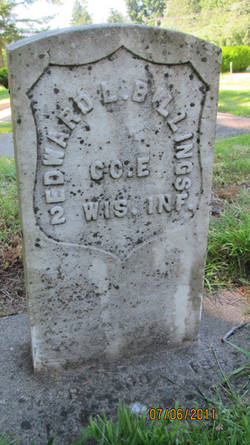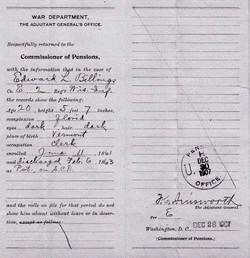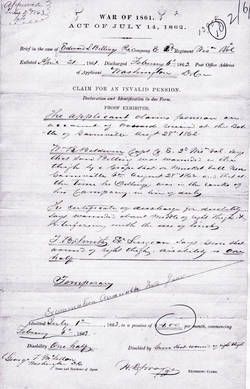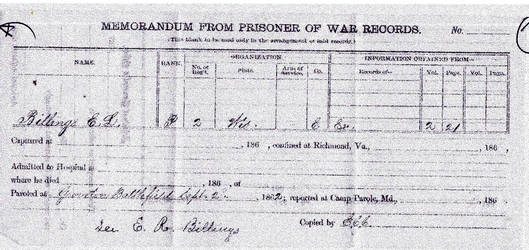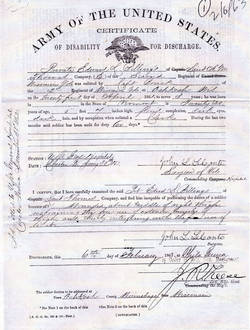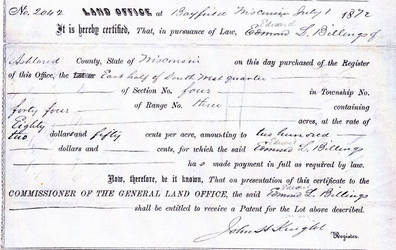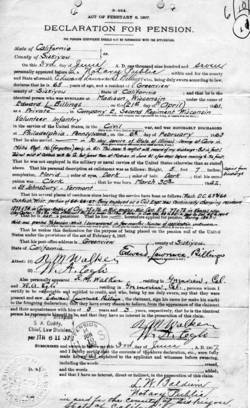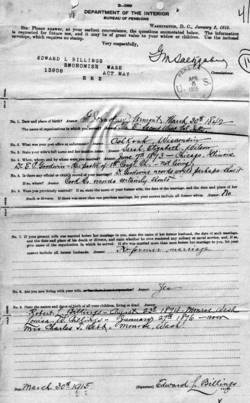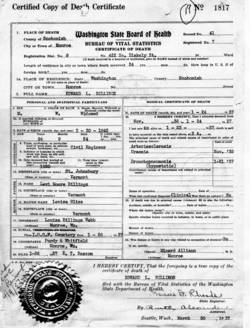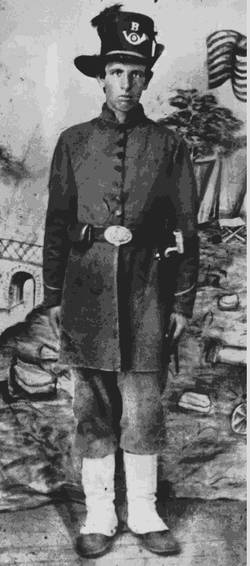Edward L. Billings
Representing: Union
G.A.R Post
- Lucius Day Post #123 Monroe, Snohomish Co. WA
Unit History
- Illinois US Light Infantry
- 2nd Wisconsin Infantry E
Full Unit History
ILLINOIS US VOLUNTEER LIGHT INFANTRY
Organized: April, 1861
Mustered In: 5/3/61 Chicago, IL (est.)
Mustered out: Inf. Not Avail.
2nd WISCONSIN VOLUNTEER INFANTRY
Organized: May, 1861
Mustered In: 6/11/61 Camp Randall, Madison, WI
Mustered Out: 7/2/64 Madison, WI.
Regimental History
REGIMENTAL HISTORY: (US LT INF)
Information pertaining to this Illinois State militia unit, including its exact name, is not available. Obviously it was formed immediately following President Abraham Lincoln's declaration of war. Further, it is not known if this was a 30-day or a 90-day unit. What is known about it is that it served in the defense of Cairo, IL for at least a portion of its period of existence. However, its final fate - whether it was mustered out at the expiration of its service life or was assimilated into another state or federal regiment is not detailed.
REGIMENTAL HISTORY: (2nd)
The 2nd, a three-year "eastern theater" regiment left the State of Wisconsin on 6/20/61 to become the first "three year" unit to appear in Washington City. Its baptism of fire came July 21, 1861 at the battle of 1st Bull Run/Manassas where it bore the brunt of a determined onset by the Confederate forces of Thomas "Stonewall" Jackson. Regimental losses were 30 killed, 125 wounded and 65 missing.
In December, 1861 the history of the 2nd merged with that of the Union Army of the Potomac's famous "Iron Brigade." The "Iron Brigade consisted of the 2nd, 6th and 7th Wisconsin, plus the 19th Indiana and 24th Michigan. It remained with that organization until being detached in May, 1864 while with the Iron Brigade its losses in terms of deaths, wounding and missing were the greatest in proportion to numbers of any regiment engaged during the American Civil War.
August, 1862 found the 2nd in action at Gainesville, VA. Shortly thereafter it saw combat at Antietam/Sharpsburg, MD. It closed the year with the fighting at Fredericksburg, VA.
Early May, 1863 saw the unit engaged at Chancellorsville, VA. In July they were prominently engaged during the first day of fighting at Gettysburg, PA.
1864: As Union forces under Gen. U.S. Grant began to move southward into Virginia in what was to become known as the Overland Campaign that would ultimately bring an end to four years of bloody civil War, the 2nd being so reduced in numbers, was assigned to provost (military police) duty until being sent home for final muster. Members who had joined the service prior to this organizational change were molded into a two company, independent battalion that took part in fighting around Petersburg, VA before being assimilated into the 6th Wisconsin Infantry as companies "G" and "H." These companies remained with the 6th until the end of the war.
Soldier History
SOLDIER: (US LT INF.)
Residence: Inf. Not Avail. Age: 19.11 yrs.
Enlisted/Enrolled: 4/19/61 Chicago, IL Rank: Pvt.
Mustered In: 5/3/61
Mustered Out: Inf. Not Avail
Highest Rank: Pvt.
SOLDIER: (2nd)
Residence: Oshkosh, WI Age: 20.2 yrs.
Enlisted/Enrolled: 6/11/61 Chicago, IL Rank: Pvt.
Mustered In: 6/11/61 Camp Randall, Madison, WI
Discharged: 2/6/63 Chester, PA
Highest Rank: Pvt.
Family History
PERSONAL/FAMILY HISTORY:
Edward L. Billings was born March 30, 1842 in Stansbury, VT to parents Levi Moore (b. 1800 VT) and Louisa (Nee Bliss b. 1806 VT) Billings. As far as is known he had two siblings, both older: Frank (b. 1831 VT) and Laura B. (b. 1840 NY). It appears that for a time the family moved back and forth between Vermont and New Hampshire. In 1831 the Billings apparently were living in Vermont as that is where son Frank was reportedly born. In 1840 during the U.S. Census and when daughter Laura L. was born, the same year the Billings were in New Hampshire. As noted, however, at the time of Edward's birth the family was back in Vermont. It was in that state census for 1850 found the household containing Levi, Louisa and their three children. At that time Levi's occupation was noted as: laborer.
1860: By the time of this census the Billings clan had again quitted Vermont, this time for Wisconsin. The "when" and "why" for that move is not documented. In that state they were residing in or near the Winnebago County community of Oshkosh. Interesting, Levi, for whatever reason - perhaps he had died - was no longer in the household. Son Frank, then twenty nine years of age and employed as a "merchant", was listed as head of the household which included his mother, Sister Laura and younger brother Edward.
In April, 1861, with war having been declared, young Edward enlisted in an Illinois State militia unit which he later claimed he served for thirty days, at least a portion of which was at Cairo, IL. Why he entered an Illinois unit at Chicago is not known. Did he travel there to enlist? Was he working there? We will likely never know. On June, 11, also in Chicago he re-enlisted in Captain Bouck's 2nd Wisconsin Infantry, an organization which later became Company E of the same regiment. Whether he had completed his period service in the Illinois unit and had been mustered out, or was allowed to leave that organization in order to join a Federal regiment - a practice which was common at the time - is, once again, not known. He did, however, in later years note that he had not enlisted at Oshkosh, his place of residence, but joined the 2nd at Madison, Wisconsin a few days before it moved to "the front."
Company and regimental muster rolls do not reflect whether Private Billings was present for duty during the latter months of 1861, but likely he was as the rolls for the 1862 months of January through July have him as present. All that changed, however when on the evening of 8/28/62 during the battle of Gainesville, VA he was wounded by a either a minie ball or a piece of artillery grapeshot which passed through his right thigh. Wounded, he was captured and imprisoned by Confederate forces.
Interpreting available military service records, Private Billings was apparently paroled from custody - likely because of his wound - in September, 1862 at Groveton, VA. (Note: Groveton was part of the site of the Battle of Second Bull Run/Manassas fought Aug. 28-30, 1862). Upon his release he was transferred to Douglas U.S.A. General Hospital in Washington, D.C. There he remained until 10/28/62 when, as a paroled soldier awaiting formal exchange papers, so he could return to duty - he was granted a 35 day furlough (home) to recuperate from his wounding. That exchange came in the month of December. At the end of that same year ending month, Private Billings was re-admitted to a U.S.A. General Hospital. On this occasion that hospital was located in Chester, Pennsylvania. From there on 2/6/63 he was granted a disability discharge from the army because the thigh wound restrained the free use of "extensor" muscles of the thigh, thereby interfering with his use of the limb. A further notation was: "There is no strength in the right leg (when) bent which causes difficulty in walking" (let alone marching!!) Considered 50% disabled, he was granted a $4 monthly U.S. Government disability pension stipend, which began as of the date of his discharge.
Separated from the service, Edward did not return to Illinois, but chose, instead, to settle in Washington, D.C. The why for this choice is not clear, but it may have been the availability of employment in that City. In later years Edward would claim his occupation was civil engineering/surveying. How and when he obtained these skills is not documented, but perhaps there was some opportunity in Washington City to acquire and/or use these talents. A pension file notation of interest is that in mid-December, 1863, apparently while in D.C. Edward had regained the use of his right leg to a point where he no longer considered himself disabled, so in (good) conscience, he relinquished his disability pension certificate.
Edward Billings appears to have remained in Washington, D.C. until sometime in early 1864 when he removed to Oshkosh, Wisconsin. Based on later documentation, the move was likely driven by employment opportunities as a surveyor/civil engineer. While in Oshkosh he appears to have resided in the home of his father and mother as that is where the 1870 U.S. Census located surveyor Billings.
Edward apparently had plans to remain in Wisconsin as on July 1, 1872 the Bayfield Wisconsin land office noted that he, then of Ashland County, had purchased 80 acres of land at a price of $2.50 per acre or a total of $200. That land office also noted his name on their register as of 1/31/73. Edward Billings apparently had a vision of settling down to a life of homestead farming. That vision, however did not materialize as on 8/15/73 his homestead application was cancelled. While there is no notation as to the why of the cancellation, it seems likely it was because surveyor/civil engineer Billings had an opportunity to become employed by the City of Chicago, IL.
Employment in Chicago was likely not the only reason for the homestead abandonment, however, as prior to the 8/15/73 relinquishment date, on 6/7/73 in Chicago, IL Edward married one Sarah Elizabeth Wilson (b. April, 1850). The union would produce two children: Robert L. (b. 8/23/74 IL) and Louise W. (b. 1/27/76 MN).
As evidenced by the birthplaces of the two Billings children, Edward and family moved a lot. In later years he would claim that because of his civil engineering/surveying duties that family resided more places than he could even remember. As best as can be determined, however, the family living locations lined up somewhat as follows: By 1875/'76 Edward was in Wisconsin employed by a railroad. During this period, when daughter Louisa was born the Billings were in Minnesota. Somewhere along in that period, either before or shortly after Minnesota they were in St. Louis, Missouri. For certain, by 1877/'78 they were in Kansas living near the community of Clay Center.
1879 and into 1880.Edward indicates that during this period he was employed working on a survey of the Mississippi and Missouri Rivers. Exactly where the family was living at the time cannot be said as available documents are illegible in that category. To further complicate matters, he and the family cannot be found in the 1880 census.
The next documental evidence for Edward's whereabouts comes from a document which states that from 1888 to 1895 the family was in Nebraska. Locales of residence in that state appear to have been firstly the community of Wymore and. later, Ogallala.
In 1895 the Billings' departed Nebraska for Lead, Lawrence Co., South Dakota. It was there the census of 1900 found surveyor Edward and Sarah. At the time Sarah noted that she had given life to two children, both of whom were living.
1907: Seven years after the last census. Edward was living in Greenview, Siskiyou County, California. It was while there the former Civil War infantryman declared for a U.S. Government disability pension based on lingering impediments/ailments which he traced back to his soldiering days. The nature of those ills are not known, but perhaps the old leg wound which had not bothered him when he was younger, was now acting up.
The Billings family did not remain long in California as in 1910 they were in Seattle, King County, Washington. The household at that time included civil engineer Edward, Sarah, and children Robert - owner of a machine shop - and Minnie.
As of 1912 the family Billings had moved northward from Seattle to the south Snohomish County community of Monroe. It was there Edward would live out his years which, in fact, were still pretty plentiful. One indication of this was the onset of his disability pension on June 4th of that year at a rate of $12.50 per month. By May of 1931 that stipend had grown to $75 and there was a recommendation that it be increased to $100 because of his having recently been stricken with partial paralysis which, allegedly, left him unable to dress, bathe or feed himself and required he have regular aid and attendance from another. Hmmmmm...Let's see where this goes!!
1920: As of that census year Edward, then 77 years of age, was employed in some capacity by the Monroe Police Department. Children Robert and Louisa who five years before were still living under he and Sarah's roof, were now residing elsewhere either within or not many miles from Monroe. It would later be said document ally that 1920 was the last year Edward was gainfully employed.
On February 22, 1933 Sarah died. She was buried in the Monroe I.O.O.F. cemetery.
In April, 1936 a pension investigator conducted an assessment of Edward's living situation and wrote, in part, the following: “(The old veteran) lives at 422 Blakely Avenue in Monroe with his daughter. Only she and the veteran are in the household. Son Robert lives in Mt. Vernon (Skagit Co., WA). .....A guardian is not needed.....The veteran has about 40 acres of land near Clay Center, Kansas and owns his own home in Monroe. (He has) no other income aside from (his) pension. (He is) sufficiently and properly clothed. (His) living environment is good. (He) spends time around home (and) signs his own checks. (He) takes walks and goes for rides with from in (an) automobile. (He) does not desire care in a soldiers’ home and much care does not seem necessary.” Obviously Edward had bounced back from some of the physical frailties which had beset him in May, 1931.
November 1st saw the health of 93 year old Edward L. Billings begin to fail. As of the 26th of that month he fell under the care of a physician. That care would continue into January, 1937 when, he contracted hypostatic bronchial pneumonia.
Death came to 94.9-year-old Edward L. Billings, former Civil War soldier and surveyor/civil engineer on January 24, 1937. Cause of death was noted as arteriosclerosis and uremia. Notational information from that time was: "partially paralyzed. Confine to wheel chair for some time. Could not use right arm at all. Was dressed, undressed, etc., by constant companion Louisa Webb, daughter. Burial was in the Monroe I.O.O.F. cemetery beside Sarah.
After her father's passing Louisa requested a burial flag from the U.S. Government. She also sought $181.60 for burial expenses, $100 of which was granted. While she reapplied for the balance of the funds, that request appears to have been rejected. Still, she was awarded $80 of her late father's accrued pension benefits.
Cemetery
Buried at IOOF Cemetery Monroe
Row: Old Section
Site: E53
Adopt-a-Vet Sponsor
Karyn Zielasko Weingarden
Snohomish, WA
